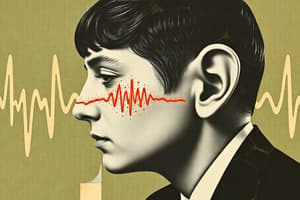Podcast
Questions and Answers
What unit is used to measure sound intensity?
What unit is used to measure sound intensity?
decibels
What is responsible for sound sensing in the Organ of Corti?
What is responsible for sound sensing in the Organ of Corti?
- Hair Cells (correct)
- Perilymph
- Endolymph
- Cilia
Sound signal transduction in mammals involves different cilia sizes.
Sound signal transduction in mammals involves different cilia sizes.
True (A)
The main mechanism for sound processing in mammals involves the mechanical properties of the basilar membrane, which is narrower and more rigid closer to the ______ ear.
The main mechanism for sound processing in mammals involves the mechanical properties of the basilar membrane, which is narrower and more rigid closer to the ______ ear.
Flashcards are hidden until you start studying
Study Notes
Audition
- Sounds are mechanical waves propagating through the air, a mix of pure sounds of different frequency and amplitude.
Anatomy of the Ear and Balance Organs
- The ear, together with balance organs, evolved from the lateral line in fish (detects water waves).
- Middle ear transfers sound waves from the eardrum to the internal ear, with pressure amplification from eardrum to oval window.
- Ear protection: nerve reflexes driven by middle ear muscle innervation protect ear structures from very intense sounds.
Auditory System
- Each species has a defined hearing range.
- Cochlea: responsible for sound sensing, contains hair cells.
- Organ of Corti: contains hair cells, responsible for sound sensing.
- Inner ear ion gradient: high K+ levels and electric gradient are generated by the epithelium at the stria vascularis.
Sound Signal Transduction
- Basilar membrane discriminates tones poorly in non-mammal vertebrates.
- Main mechanisms in non-mammal vertebrates: changes in cilia size, electric resonance.
- Main mechanisms in mammals: different cilia size, mechanical properties of the basilar membrane, existence and action of outer hair cells.
Hair Cell Activation Mechanism
- Receptor adaptation depends on Ca2+ entry and cilia bridge distribution.
- Hair cell activation mechanism: opening of non-selective cationic channels in the apical zone of stereocilia, entrance of K+ and Ca2+.
Sound Processing
- Primary pathway: cochlear nuclei present a dorsal and ventral division, with processing of auditory information in the ventral division.
- Non-primary pathway: auditory information processing from cochlear nuclei to the reticular formation, where the auditory message joins other sensory messages.
Auditory Information Processing
- Olive nuclei participate in sound localization.
- Sound localization depends on sound origin, with differences in frequency spectrum, sound intensity, and wave phase between ears.
- Auditory cortex presents tonotopic and periodotopic maps, with characteristics of cortical sound processing organized in central part (core), “belt” area, and external area (parabelt).
- Auditory cortex is organized in two processing pathways: dorsal (sound localization) and ventral (sound identification).
Studying That Suits You
Use AI to generate personalized quizzes and flashcards to suit your learning preferences.




